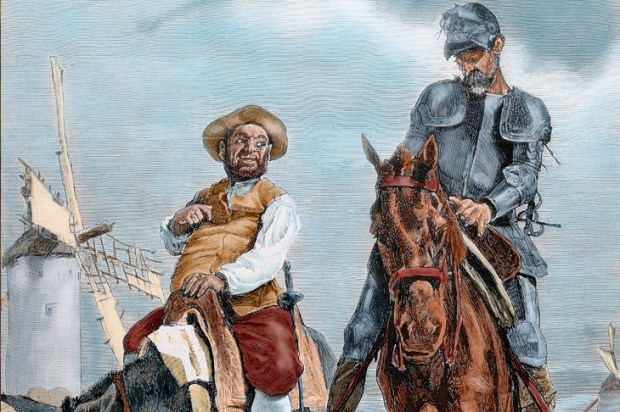If social media manipulation has influenced elections, and dark money has influenced our elected representatives, then we are already on the road to unfreedom, as Timothy Snyder, the well-known historian of Russia, argues in his new book. He sees threats to democracy in Europe and America as following the Russian model of oligarchic takeover: ‘The stabilisation of massive inequality, the displacement of policy by propaganda, the shift from the politics of inevitability to the politics of eternity.’
Snyder focuses on the Ukrainian crisis, noting how this conflict became a theatre of cultural memory: during the Russian invasion it was once again 1941, the enemies were Nazis, and tanks were even painted with slogans such as ‘For Stalin’. Leftists in the West particularly fell for Russia’s version of events. Snyder shows John Pilger and Seumas Milne parroting information from Russian propaganda sites arguing that the protests in Ukraine were led by fascists, and points out how western coverage bought into the divisive narrative of ‘ethnic Russians’ and ‘ethnic Ukrainians’, based on language use. In fact many Ukrainians use both, including those who were protesting against Russia’s actions. Snyder’s informative timeline of events on the ground in Ukraine is vivid, and offers a much greater understanding of how this conflict emerged than we got in most English-language news coverage.
Snyder also illustrates how propaganda was used to sell the Crimean annexation to the Russian public. The campaign relied on stirring resentment against the West — along with some strange beliefs. Foreign influence was blamed for creating trouble in Ukraine, and this was connected to a particular western threat: dangerous homosexuality. Snyder explains the degree to which ‘gays and Jews’ are seen as the enemy in Russia’s political commentary. Jews are, unfortunately, accustomed to this; but gays will be surprised to learn that the EU is run by a homosexual cabal.
Yet, even as their missiles were flying in the Crimea, the Russian government officially denied involvement, describing the conflict as a civil war. Snyder talks about this kind of ‘plausible deniability’, asserting that it originated with the Southern Strategy of the US Republicans in the 1970s, who pursued racist policies without being explicitly racist. While the concept is no doubt as old as human subterfuge, the term ‘plausible deniability’ was coined by Allen Dulles at the CIA during the Kennedy administration. He was talking about being able to deny covert operations — a far closer analogy to Russia’s half-denials of actions in Ukraine than racially-tinged campaign promises about school funding.
Where Snyder is more acute is in drawing parallels between Trump and Russian oligarchs, and pointing to more people being cut out of democratic processes and political access. The wealth at the top is part of the problem: the 1 per cent have influence in ways that no ballot box could effect. He is right about democracy failing when the voters themselves have no faith in the process, and voter faith is being undermined — for instance, by the Russian meddling scandal in the US. He feels that inequality is the greatest threat to democracy’s survival.
In How Democracy Ends, David Runciman offers a broader analysis. He talks about how ideally in a democracy, popular will can change policy direction.
Runciman praises, for instance, Rachel Carson’s Silent Spring for bringing environmental issues into public consciousness in the 1960s, leading to the banning of DDT. (Whether this was a good thing in the long run is another issue; there are millions who have died from malaria since then who might not have if DDT was still in use for mosquito control.) But Carson’s work did make a change. Runciman argues that such a tactic — increasing public awareness of coming catastrophe — would not work today, however. We have ‘apocalypse fatigue’. Since the 1960s, a series of doomsayers have told us we would all be dead by now, thanks to overpopulation, nuclear holocaust, a new Ice Age, the Aids pandemic or global warming. Nonetheless, each of these scares (some more realistic than others) has affected policy, just not necessarily in a democratic way.
If the issue is democracy, a better question is how trendy ideas end up capturing the elite and becoming policy, the democratic will of the people be damned. Perfect examples of this are ‘green energy’, mass immigration and the sugar tax. On these fronts, the end of democracy started long before Donald Trump — or perhaps it never really existed. Even in mature democratic states there has always been a ‘ruling class’ who claimed to know better than everyone else. Sometimes they did, but the question is, better for whom? The interests of Davos Man and Silicon Valley executives don’t coincide with those of the rest of the population.
Runciman considers at length the alternatives to democracy: pragmatic authoritarianism, epistocracy (rule by those who ‘know better’) and liberated technology. They all have pros and cons, and Runciman sees our most likely trend as towards liberated technology, in which we end up being ruled by our machines — for better or worse. Nonetheless, he is encouraged by democracy’s survival — and revival — in countries where it has been challenged by coups or dictatorships. The last two years have seen plenty of political books on the theme of ‘democracy in crisis’. Refreshingly, rather than a knicker-twisting diatribe about Trump and Brexit, Runciman offers a thoughtful analysis about what popular democracy means, and its alternatives.
Got something to add? Join the discussion and comment below.
Get 10 issues for just $10
Subscribe to The Spectator Australia today for the next 10 magazine issues, plus full online access, for just $10.
You might disagree with half of it, but you’ll enjoy reading all of it. Try your first month for free, then just $2 a week for the remainder of your first year.














Comments
Don't miss out
Join the conversation with other Spectator Australia readers. Subscribe to leave a comment.
SUBSCRIBEAlready a subscriber? Log in